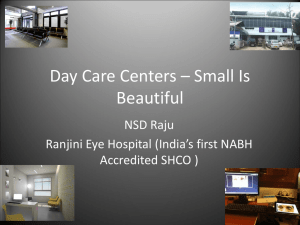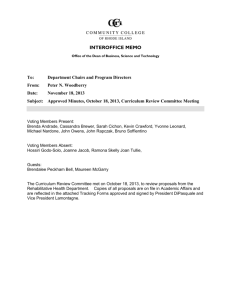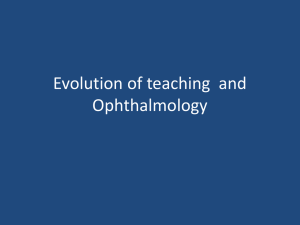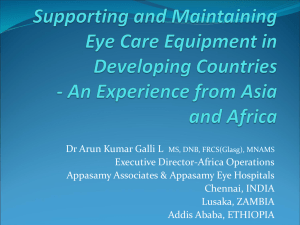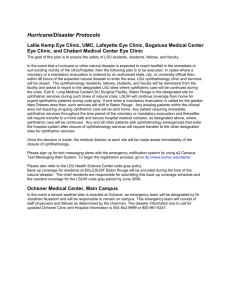NATIONAL PROGRAMME FOR CONTROL OF BLINDNESS (1
advertisement
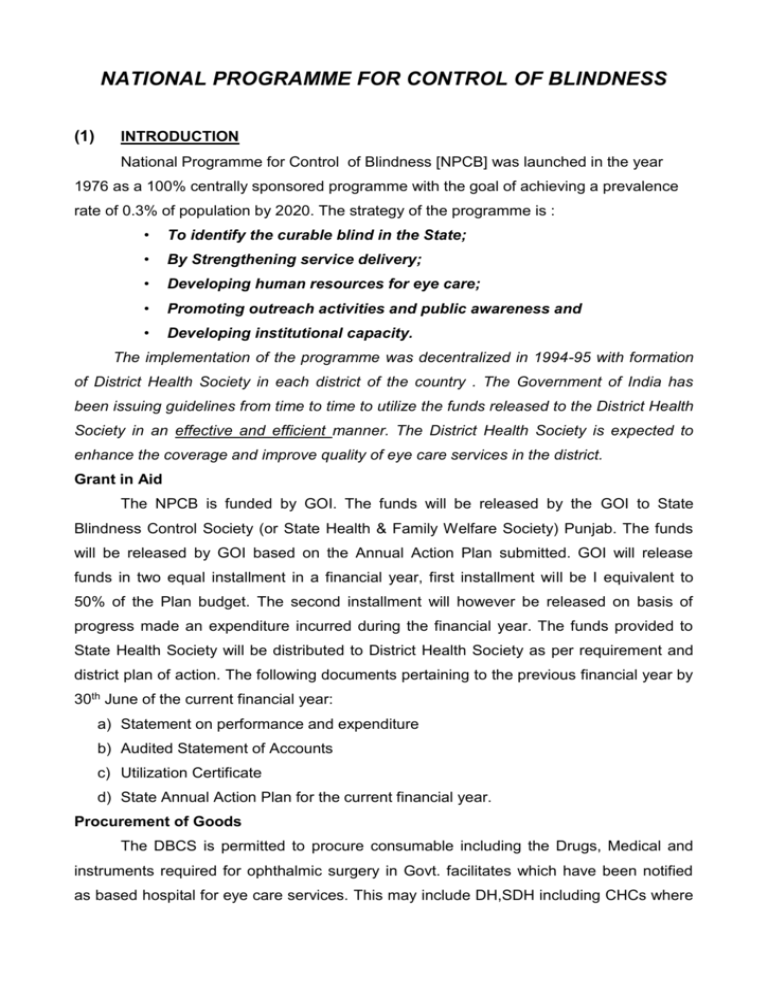
NATIONAL PROGRAMME FOR CONTROL OF BLINDNESS (1) INTRODUCTION National Programme for Control of Blindness [NPCB] was launched in the year 1976 as a 100% centrally sponsored programme with the goal of achieving a prevalence rate of 0.3% of population by 2020. The strategy of the programme is : • To identify the curable blind in the State; • By Strengthening service delivery; • Developing human resources for eye care; • Promoting outreach activities and public awareness and • Developing institutional capacity. The implementation of the programme was decentralized in 1994-95 with formation of District Health Society in each district of the country . The Government of India has been issuing guidelines from time to time to utilize the funds released to the District Health Society in an effective and efficient manner. The District Health Society is expected to enhance the coverage and improve quality of eye care services in the district. Grant in Aid The NPCB is funded by GOI. The funds will be released by the GOI to State Blindness Control Society (or State Health & Family Welfare Society) Punjab. The funds will be released by GOI based on the Annual Action Plan submitted. GOI will release funds in two equal installment in a financial year, first installment will be I equivalent to 50% of the Plan budget. The second installment will however be released on basis of progress made an expenditure incurred during the financial year. The funds provided to State Health Society will be distributed to District Health Society as per requirement and district plan of action. The following documents pertaining to the previous financial year by 30th June of the current financial year: a) Statement on performance and expenditure b) Audited Statement of Accounts c) Utilization Certificate d) State Annual Action Plan for the current financial year. Procurement of Goods The DBCS is permitted to procure consumable including the Drugs, Medical and instruments required for ophthalmic surgery in Govt. facilitates which have been notified as based hospital for eye care services. This may include DH,SDH including CHCs where Eye Surgeons are posted. The District Health Society will be required to constitute a purchase committee comprising of CMO, district ophthalmic Surgeon, DPM and officer of the another deptt. preferably having knowledge of procurement and financial procedures to procure the items required by the District Health Society. The evaluation of the bids should not be based on the criteria of lowest cost alone but the quality should also be considered . Provision of spectacles : Students with refractive errors who cannot afford to pay for spectacles would be borne by District Health society to the maximum upper limit of Rs.200/-. The price of spectacles must be fixed based on an opened tender basis ensuring quality of glasses as per specifications (English Glass) at a competitive price Objectives of NPCB 1. To reduce the backlog of blindness through identification and treatment of blind 2. To develop Comprehensive eye care facilities in every district. 3. To develop human resources for providing eye care services. 4. To improve quality of service delivery. 5. To secure participation of Voluntary organizations/Pvt. Pract. in eye care 6. To enhance community awareness on eye care.. Activities 1. 100 percent achievement of Cataract operation of which 90% will be IOL and 10% for simple cataract surgery 2009-10. 2. Annual Eye check up of all incumbents of blind schools covering the visual acuity, fundus examinations and other appreciate advance test required to assess chances of visual restoration. Eye check up of applicants who desire to seek admission in a blind school and issue of certificate of incurable blindness recommending admission to a blind school. No person would be admitted to blind school without this certificate. Eye check up of the incumbents of blind schools including special investigation. 3. Follow up of treated cases as per recommendation of ophthalmic board. 4. Rehabilitation of incurable blind would be as per scheme of department of social welfare. 5. Low vision Aids to screen all school going children for refractive errors and provide spectacles free of cost. 6. As per approved PIP 2009-10 Ophthalmic Assistant @ Rs. 8000pm are being recruited soon at district level. 7. As per approved PIP 2009-10 5 Eye Cousellors @ Rs. 10,000 pm are being recruited soon. Financial Assistance District Blindness Control Society would be empowered to use GOI grant released under NPCB to meet expenses on the following: 1. Eye Check up of incumbents of blind school including special investigations; 2. Medical and/or surgical treatment of referred cases including medicine prescribed after treatment/surgery. 3. Low vision Aids and/or spectacles prescribed. 4. TA/DA to members of the Board for travel relating to the scheme. Focus in 2010-11 1. Eye collection centres to be established in all the districts of the State. 2. To achieve 100% target of cataract operations. 3. To provide following eye equipments at Sub Divisional Hospitals for effective eye care services: Slit Lamp, A-scan, operating Microscope, Keratometer, vision drum (Distant and near) Trial Frame and Trial Set. 8. Strengthening of Vision Centers in all districts of the State. (2) STRATEGY OF 11TH PLAN Proposed pattern of assistants and strategy for 11th plan a) Keeping in view austerity measures and to avoid duplicity of work, State Ophthalmic Cell has been merged with State Blindness Control Society. Due to formation of National Rural Health Mission (NRHM), State Blindness Control Society (SBCS) under NPCB has been further merged with State Health Society under NRHM. District Blindness Control Society (DBCS) under NPCB has also been merged with District Health Society under NRHM. Funds for implementation of the programme would be released through State Health Societies in the form of Grant in Aid. b) Increase in assistance for commodity to various facilities to increase their capacity for treatment of all types of eye ailments. c) Facility for IOL implantation expanded upto Taluka level. d) Marginal increase in grant in aid to Eye Banks, Eye Donation Centres and NGOs due to escalation of costs and to improve quality of services. e) In addition to cataract, assistance would also be provided for other eye diseases liked Diabetic Retinopathy, Glaucoma Management, Laser Techniques, Corneal Transplantation, Vitreoretinal Surgery, Treatment of Childhood blindness etc. f) Assistance for construction of dedicated Eye wards and Eye Operation Theatres in North East States and few other states as per need. g) Assistance for appointment of ophthalmic manpower – ophthalmic surgeons, ophthalmic Assistants and Eye Donation Counsellors on contractual basis. h) Assistance for involvement of Private Practitioners in sub-district, block and village levels. i) Assistance for maintenance of ophthalmic equipments supplied under the programme. j) Development of Mobile ophthalmic units with Tele-ophthalmology Network and some fixed tele-models to cover difficult hilly terrains and difficult areas. k) Critical posts of 228 Eye Surgeons and 510 ophthalmic Assistants sanctioned during the 9th plan and continued during 10th plan, would be integrated within the State Plan in a phased manner during the current plan period. l) Strengthening of Management Information system. m) Intensification of IEC activities. Strengthening/setting up of Regional Institutes of Ophthalmology Non-recurring assistance upto Rs. 60 lakh for new RIOs and Rs. 40 lakh for existing RIOs for providing ophthalmic equipments for developments of pediatric eye units/ low vision units/ retina units, audio visual aids and training infrastructure, IOL Surgery & all other Sub specialties etc. List of equipment is as under : 1. Operating Microscope with Assistant scope & Cornea attachments. 2. A-scan Biometer 3. Keratometer 4. Slit Lamp 5. Yag Laser 6. Applanation Tonometer 7. Auto Refractometer 8. Vitrectomy Unit complete with endolaser photocoagulator 9. Flash Autoclave 10. Automated Perimeter with field analyser 11. Phacoemulsifier 12. Double Frequency Yag Laser/Argon Green Laser 13. Fundus Fluoresce in Angiography 14. Streak Retinoscope 15. Tonometer (Schiotz) 16. Director Ophthalmoscope 17. Indirect Ophthalmoscope 18. Low vision Aid devices – High plus spectacles, Hand held magnifiers, Stand magnifiers, Telescopes, Videomagnifires, Field Expanding devices, Absorptive Lenses 19. B-Scan 20. Fundus Camera Digital 21. Teller visual acuity cards/Cardiff cards. 22. A set of trial lens box and trial frame including trial frame for children 23. 90 D lens, 78D lens, 20 D lens 24. Ishihara Colour Vision book 25. Synptophore 26. Tonopen 27. Worth 4 dot set with red and green glasses and rotating test durm 28. Loose prism set 29. Prism bar, Maddox wing, tangent scale 30. RAF under, Bagolini Glasses 31. Instruments for examination under general anesthesia 32. Cardiac monitor with defibrillator 33. Paediatric oculopasty surgery etc. 34. BP apparatus with paediatric etc. 35. Surgical sets for all subspecialties 36. Microsurgical instruments including SICS blades and phaco brobes 37. Instruments for management of ocular trauma, Keratoplasty set, instruments for lid surgeries, instruments for enuculeation, entropion, Ectropion etc. 38. Vision Charts-Snellens/Logmar 39. Refraction Units 40. OCT( Optical Cohrence Tonography) 41. Air-Conditioners 42. Pulse-oxymeter 43. Generator 44. Surgical Sets for all sub specialties 45. Aut Kerato Refractometer 46. Laser/Argon and Yag with silt lamp delivery, indirect ophthalmoscope LIO, endolaser 47. IOLs 48. Sutures 4-0,8-0,10-0 49. Gonioscope 50. Consumables for phaco surgery 51. SICSX 52. Paymen Capsulotomy Lens 53. Abraham Iridotomy Lens 54. Mainster Lens- Central Fundus 55. Maisnter Lens 56. Fluorescein strips 57. Schirmer Tear Test strips 58. Rose Bengal Strips 59. Lissamine Green Strips 60. Lander's Vitrectomy Lens set 61. Lander's Vitrectomy Lens set (Plano,videfield, biconcave) 62. Vitretomy Irrigating Lens set (Plano,widefield, biconcave 63. Silicon Oil injector 64. Intraocular Magnet (Titanium Handle) 65. Endocapsular Tension ring 66. Consumables for ophthalmic surgery (like viscoelastic, Ringer bactale etc.) Strengthening of Medical Colleges Non-recurring commodity assistance upto Rs. 40 lacs for providing ophthalmic equipments as commodity assistance for development of paediatric eye units/ low vision units/retina units. List of equipments is as under: 1. Operating Microscope with Assistant scope & Cornea attachments. 2. A-scan Biometer 3. Keratometer 4. Slit Lamp 5. Yag Laser 6. Applanation Tonometer 7. Auto Refractometer 8. Vitrectomy Unit complete with endolaser photocoagulator 9. Flash Autoclave 10. Automated Perimeter with field analyser 11. Phacoemulsifier 12. Double Frequency Yag Laser/Argon Green Laser 13. Fundus Fluoresce in Angiography 14. Streak Retinoscope 15. Tonometer (Schiotz) 16. Director Ophthalmoscope Strengthening of District Hospital Non-recurring commodity assistance upto Rs. 20 lacs for Ophthalmic Equipments for IOL Surgery. List of Equipment is as under: 1. Operating Microscope 2. A-scan Biometer 3. Keratometer 4. Slit Lamp 5. Yag Laser 6. Applanation Tonometer 7. Auto Refractometer 8. Flash Autoclave 9. Streak Retinoscope 10. Tonometers (Schiotz) 11. Direct ophthalmoscope Degradation of Sub-distt. Hosptial Non-recurring commodity assistance upto Rs.5 lacs for ophthalmic equipments for IOL Surgery. List of equipment is under: 1. Operating Microscope 2. A-scan Biometer 3. Keratometer 4. Slit Lamp 5. Auto Refractometer 6. Flash Autoclave 7. Streak Retinoscope 8. Tonometers (Schiotz) 9. Direct ophthalmoscope Vision Centres at PHCs/ in Vol. Sector Non-recurring assistance upto Rs. 50,000 for basic equipments, furniture and fixtures, GIA to DECS would be used for Vision Centres at PHCs. For Voluntary Sector, assistance would be provided as GIA. Details are as under1. Trial Lens 2. Trial Frames (Adult and Child) 3. Illuminated Vision Testing Drum 4. Plane mirror for retinoscopy 5. Streak Retinoscpe 6. Snellen & Near Vision Charts 7. Binomag/Magnifying Loupe 8. Tonometer (Schiotz) 9. Battery Operated Torch (2) 10. Lid speculum 11. Eplipation forceps 12. Foreign body spud and needle 13. Director Ophthalmoscope 14. Slit lamp (optional) 15. Vision Charts for preverbal children Support to Eye Banks in Government/Voluntary Sector Non-recurring assistance upto Rs. 15 lakh for equipments and furnishing towards strengthening/developing eye bank by GOI. Details are as under1. Slit Lamp Microscope 2. Operating Microscope with camera attachment 3. Specular Microscope 4. Laminar Flow 5. Serology Equipment 6. Instruments for corneal excision and enucleation including containers 7. Autoclave 8. Keratoplasty instruments 9. Transport facility (one 4 wheeler & One 2 wheeler) 10. Refrigerator 11. Computer & Accessories 12. Telephone Line 13. Air-Conditioner 14. Renovation, Repair, Furniture & Fixtures Support to Eye Donation Centres in Government/Voluntary Sector Non-recurring Assistance upto Rs. 1 lakh for strengthening/developing Eye Donation Centre. Recurring assistance of Rs. 1000 per pair of eyes collected towards honorarium of eye bank staff, consumables including preservation material & Media transportation/travel cost/POL and Contingencies, Recurring GIA would be paid through Affiliated Eye Bank. (3) FINANCIAL & PHYSICAL STATUS District wise details of Financial & Physical are attached as Annexure 'I' & 'II". Performance of various Target given under this programme:Eye Care Services Cataract IOL implantation School Children Screened Refractive Errors Spects Distributed Teacher Trained Eye Donation Target 2009-10 1,80,000 1,62,000 3,50,000 21,000 6,300 4,000 800 Achievement % age 1,67,770 1,59,645 5,28,000 33,817 10,803 5441 1280 93.2 98.5 151 161 171 136 160 Budget and Expenditure In the year 2009-10 Grant in Aid of Rs. 2,82,42,000 was received from GOI out of which 1,22,00,000 lac were distributed to District Blindness Control Society according to their demand and further distributed to NGOs/Govt. Institutes (Annexure 'III'). (4) ACTION PLAN 1. In the year 2009-10, 4 Yag Laser has been purchased & it has been written to S.P Branch for installation in 4 District Hospitals. 2. Under IEC activity an advertisement has been given in Regional News paper for prevention of eyes on eve of festival and pamphlets has been published and distributed in district. On 8th October, 2009 (World Eye Sight Day) work has been done to aware public and 6 hoardings are being placed in Major Cities of the State displaying message on mortuaries, cremation grounds, hospitals and other public gathering places for Eye Donation of Eye Donation and Other Eye Diseases. 3. With the help of Eye Banks out of which 3 are Govt. (Principal Medical college Amritsar, Faridkot & Patiala) and 2 are Private ( Punorjot Eye Bank Regd. & Shri Guru Harkrishan Charitable Trust, Sohana (Mohali) public awareness camp has been organized for Eye Donation. To aware public regarding Eye diseases like Glaucoma and Diabetic Retinopathy celebration was done by Punorjot Eye Bank Society, Ludhiana on 12th March 2010. 4. Equipments will be purchased by PHSC according to the demand received from Govt. Medical College Amritsar (RIO) and Govt. Medical College, Patiala as per list of equipments supplied by GOI. 5. 6 Batches of PMOAs were deputed for training held by Govt. of India at Chittarkut. 6. Recurring GIA to District Health Society for NGOs for per performing free cataract operation and other Intra-ocular Surgeries determined by following table:1. 2. 3. 4. 5. 6. Drugs and consumable Sutures Spectacles Transport/POL Organization & Publicity IOL, Viscoelastics & additional Consumables TOTAL ECCE/IOL 200 50 125 100 75 200 SICS/PHACO 200 0 125 100 75 250 750 750 Grant-in-Aid for NGOs for management of other Eye Disease (other than Cataract) like Diabetic Retinopathy, Glaucoma Management, Laser Techniques, Corneal Transplantation, Vitreoretinal Surgery, Treatment of Childhood Blindness etc. is Rs. 1000 per case.
